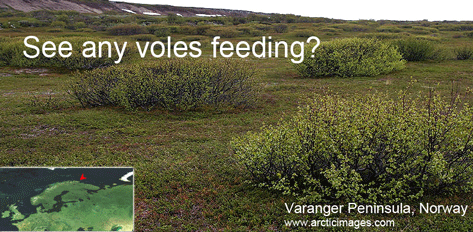Finding out what small herbivores eat
What do animals eat? For many animals other than large, diurnal, terrestrial species, this is surprisingly hard to study. In August 2009 Frontiers Zool researchers from Norway and France apply standardized DNA analysis, and compare with microscopic techniques, for diets of two arctic voles, Microtus oeconomus (Tundra vole) and Myodes rufocanus (Grey red-backed vole) collected in July and September in northern Norway. Soininen and colleagues analyzed stomach contents of 48 individuals using a microscope and a DNA sequencer, the latter to analyze amplified P6 loop (length 10-46 bp) of chloroplast trnL intron. As previously described by some of the same authors (Taberlet et al 2007) P6 loop is amplifiable from diverse gymnosperms and angiosperms with a single set of primers, however not surprisingly this very short segment often does not provide species-level identification even with local flora.

For microhistological analysis, the authors first prepared a photographic guide by collecting samples of all vascular plant species in study area; the samples were dried, scraped to reveal epidermis, bleached, boiled in table vinegar, then 40x micrographs were taken. Stomach content samples were filtered, bleached, and 1 droplet was examined on a microscope slide, counting 25 bits of identifiable material; if >95% of material was unidentifiable, a new slide was prepared. In 4 individuals, no slide with adequate amount of microscopically identifiable material count be made. For DNA analysis, The P6 loop was amplified, using tagged primers that identified each individual, and the pooled material was analyzed by pyrosequencing, and the sequences were compared to a database of 842 species representing “all widespread and/or ecologically important taxa of the arctic flora”. With standardized DNA approach (the authors call this DNA barcoding although it does not use recently agreed-upon standard loci) “75% of sequences were identified at least to genus level, whereas with microhistological method, less than 20% of the identified fragments could be specified at this level”.
As a result of greater resolution as compared to microscopy, DNA identified more plant species and genera in vole diets (for M. oeconomus, 13 species/9 genera vs 9 species/5 genera; for M. rufocanus 17 species/8 genera vs 11/7). Both methods showed large variation among individuals. Limitations to DNA approach include possible overrepresentation of species with chloroplast-rich tissues and inability of P6 to detect fungi, horsetails, and mosses. Looking ahead, researchers conclude “DNA-based technology makes it possible to study vole-plant interaction by non-destructive sampling of faeces in the natural habitats of voles”, first identifying rodent species using a mitochondrial DNA marker (and potentially sex and individual identification with Y-chromosome and microsatellite detection) and then diet analysis. I conclude standardized DNA analysis opens wide avenues for ecology.
This entry was posted on Sunday, September 27th, 2009 at 8:39 pm and is filed under General. You can follow any responses to this entry through the RSS 2.0 feed. Both comments and pings are currently closed.